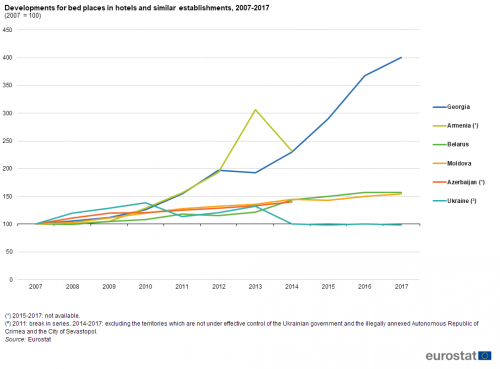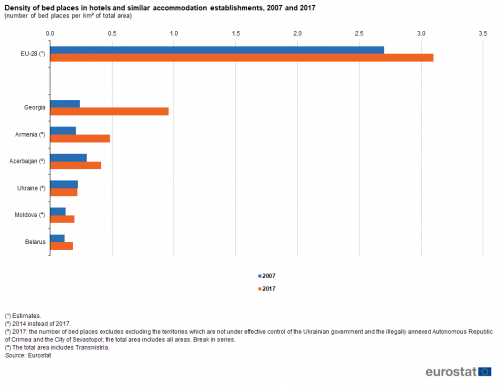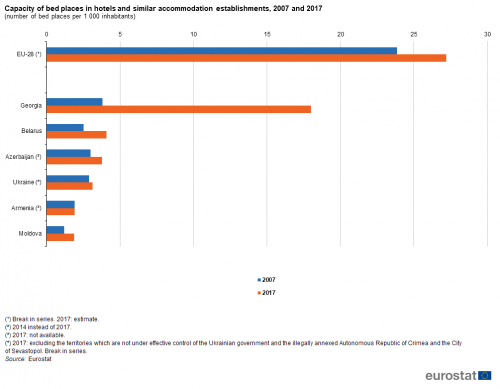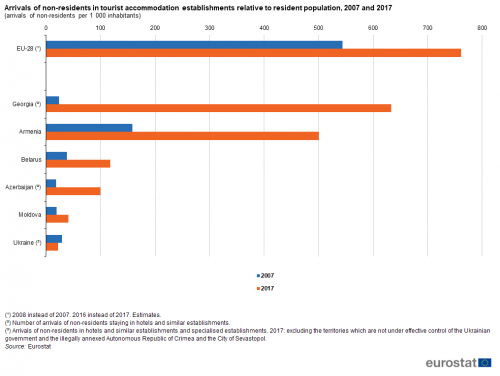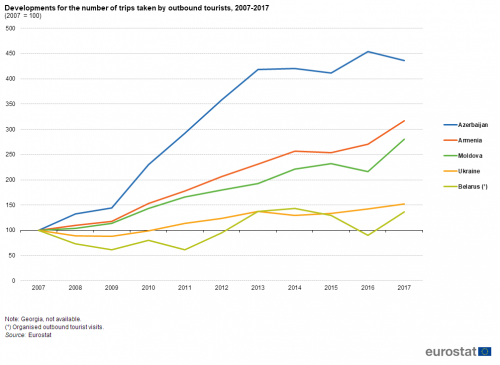Archive:European Neighbourhood Policy - East - tourism statistics
Data extracted in December 2018.
Planned article update: January 2020.
Highlights
There were just under 300 thousand bed places in hotels and similar establishments across the ENP-East countries.
In 2017, 7.0 million non-residents arrived in the tourist accommodation establishments of the ENP-East countries.
In 2017, the number of outbound trips taken by tourists from Ukraine reached 26.4 million.
Developments for arrivals of non-residents staying in tourist accommodation establishments, 2007-2017
This article is part of an online publication and presents information relating to tourism in the European Union (EU) and in the six countries that together form the European Neighbourhood Policy-East (ENP-East) region, namely, Armenia, Azerbaijan, Belarus, Georgia, Moldova and Ukraine. Note that data shown in this article for Georgia exclude the regions of Abkhazia and South Ossetia over which the government of Georgia does not exercise effective control and data for Moldova exclude Transnistria. The latest data for Ukraine may refer to a number of different geographical areas (see specific footnotes for precise coverage).
This article highlights recent developments concerning the number of bed places in hotels and similar establishments, the number of arrivals of non-residents at tourist accommodation establishments and the number of outbound trips made by tourists.
Full article
Tourism infrastructure
There were just under 300 thousand bed places in hotels and similar establishments across the ENP-East countries; almost half of these were in Ukraine
The number of bed places available in hotels and similar establishments provides one measure of a country’s capacity to attract tourists; note that official tourism statistics include business travellers as tourists alongside individuals travelling for pleasure or other reasons. In 2017, the six ENP-East countries had a combined total of 295 thousand bed places (the latest information for Armenia and Azerbaijan refers to 2014). By comparison, there were 13.9 million bed places in hotels and similar establishments across the EU-28 in 2017.
Among the ENP-East countries, Ukraine had by far the highest number of bed places in hotels and similar establishments, at 133 thousand in 2017, which equated to 45 % of the total number of bed places available within the six ENP-East countries. Note that the large fall between 2013 and 2014 in the number of bed places in Ukraine shown in Table 1 reflects to a large extent the change in geographical coverage of Ukrainian data, in particular the exclusion of the Autonomous Republic of Crimea and the City of Sevastopol. The next largest number of bed places among ENP-East countries was in Georgia, where there were 67 thousand in 2017.
Aside from Ukraine, the number of bed places grew in all of the ENP-East countries during the last decade
Figure 1 provides information on the development of the number of bed places in hotels and similar establishments over the period 2007-2017. Note that the development for Ukraine is influenced by a break in series in 2011 and a change in the geographical coverage in 2014. With the exception of Ukraine, all of the remaining ENP-East countries reported a marked expansion in their bed capacity during the period shown, with the number of bed places quadrupling in Georgia. For comparison, there was an overall increase of 17.2 % in the total number of bed places available across the EU-28 in hotels and similar establishments between 2007 and 2017.
Figure 2 presents an alternative measure for analysing the number of bed places in hotels and similar establishments, showing this information in relation to the total area of each country. It illustrates that there was a considerably higher density of bed places per square kilometre (km²) in the EU-28 than any of the six ENP-East countries. Indeed, with an average of 3.1 bed places per km² in 2017, the EU-28 had a ratio that was more than three times as high as that in Georgia, which posted the highest density among the ENP-East countries (1.0 bed places per km²). Note that the number of bed places in Moldova and Ukraine has a narrower geographical coverage than the area and as such these values are underestimates.
A final analysis for the number of bed places is presented in Figure 3: it compares the number of bed places in hotels and similar establishments with the number of inhabitants in each country. Using this measure, the EU-28 again recorded a higher capacity of bed places than any of the ENP-East countries. There were, on average, 27.2 bed places in hotels and similar establishments per 1 000 inhabitants across the EU-28 in 2017. This was about one and a half times as high as the ratio recorded in Georgia (18.0 bed places per 1 000 inhabitants) and nearly seven times as high as the ratio in Belarus (4.1) which was the next highest ratio among the ENP-East countries. The fastest expansion among the ENP-East countries in the number of bed places per 1 000 inhabitants between the years shown in Figure 3 was clearly in Georgia, where the number of bed places relative to the population was 4.7 times as high in 2017 as it had been in 2007.
Non-resident arrivals
Some 7.0 million non-residents arrived in tourist accommodation establishments in the ENP-East countries
In 2017, there were 7.0 million arrivals of non-residents at tourist accommodation establishments across the six ENP-East countries. This figure could be compared with a total of 389 million arrivals of non-residents at tourist accommodation establishments in the EU-28 in 2016 (see Table 2). Non-resident arrivals in the six ENP-East countries in 2017 were equivalent to 1.8 % of the EU-28 total in 2016. Indeed, the EU is a major tourist destination: according to the United Nations World Tourism Organisation, five EU Member States (France, Spain, Italy, the United Kingdom and Germany) were among the world’s top 10 destinations in 2017 — both in terms of international tourist arrivals and international tourism receipts.
Figure 4 shows the development of the number of arrivals of non-residents staying in tourist accommodation establishments during the period 2007-2017. There was an increase in the number of arrivals of non-residents in the six ENP-East countries, except for Ukraine where the number fell greatly in 2014; at least part of the reduction could be attributed to changes in the geographical coverage of the data. The fastest expansion in the number of arrivals of non-residents was recorded in Georgia, as the number of arrivals in 2017 was 23 times as high as it was in 2007. Although much slower, the pace of growth for non-resident tourist arrivals was also considerable in Azerbaijan, Belarus and Armenia, as their number was between three and six times higher in 2017 than in 2007, while in Moldova the number of arrivals doubled during the same period.
Figure 5 shows the number of arrivals of non-residents at tourist accommodation establishments relative to the number of (resident) inhabitants. In the EU-28 there were 762 arrivals of non-residents per 1 000 inhabitants in 2016. Among the ENP-East countries, the ratio of non-resident arrivals to population was consistently lower than in the EU-28. The highest value was recorded for Georgia, with 633 non-resident arrivals per 1 000 inhabitants in 2017 (arrivals in hotels and similar establishments only), while there were less than 50 non-resident arrivals per 1 000 inhabitants in Moldova and Ukraine. Nevertheless, the number of non-resident arrivals relative to population increased at a relatively fast pace in several of the ENP-East countries. The largest gain in relative terms was recorded in Georgia, where this ratio increased 27-fold between 2007 and 2017 (again based on arrivals in hotels and similar establishments only).
Outbound tourism
The number of outbound trips taken by tourists from Ukraine reached 26.4 million in 2017
This final section details the outward flow of tourists travelling abroad. EU-28 tourists made 331 million non-domestic trips in 2017; note that EU-28 data for this particular indicator only refer to persons aged 15 years and over.
By contrast, among the five ENP-East countries for which data are available (no information for Georgia) the highest number of outbound trips taken by tourists was recorded for Ukraine — the most populous of the ENP-East countries — at 26.4 million in 2017. There were 3.4 million outbound trips made by tourists from Azerbaijan in 2017, while the number of outbound trips from Armenia was 1.5 million, from Belarus it was 0.7 million (data refer only to organised visits) and from Moldova it was 0.2 million (see Table 3).
Developments for the number of outbound tourist trips between 2007 and 2017 are shown in Figure 6. There was a rapid expansion in the number of outbound tourist trips from Azerbaijan, with the most recent number of outbound tourists 4.4 times as high as in 2007. For Armenia and Moldova there were also substantial increases, with their numbers of outbound tourists in 2017 some 3.2 and 2.8 times as high as they had been 10 years earlier. For Ukraine there was a more modest increase in the number of outbound tourist trips between 2009 and 2017, interrupted by a fall in 2014. By contrast, the number of organised outbound visits made by tourists from Belarus fell between 2007 and 2011, before recovering somewhat in 2012, 2013 and 2014, falling again in 2015 and 2016 and increasing once more in 2017: overall the number of organised outbound tourist visits was 37 % higher in 2017 than in 2007.
Figure 7 presents the number of outbound trips taken by tourists relative to the resident population. In the EU-28 there were, on average, around 650 trips per 1 000 inhabitants in 2017; note that the tourist trip figures relate to persons aged 15 years and over.
Ukraine recorded the highest number of outbound trips per 1 000 inhabitants among the ENP-East countries, at 623 trips per 1 000 inhabitants in 2017. This was considerably higher than the number of trips made from Armenia (496 per 1 000 inhabitants) or Azerbaijan (351), while the ratio of the number of trips made by outbound tourists relative to the population was considerably lower in Belarus (74; organised outbound tourist visits) and Moldova (65).
Source data for tables and graphs
Data sources
The data for ENP-East countries are supplied by and under the responsibility of the national statistical authorities of each country on a voluntary basis. The data result from an annual data collection cycle that has been established by Eurostat. These statistics are available free-of-charge on Eurostat’s website, together with a range of additional indicators for ENP-East countries covering most socio-economic topics.
Tourism, in a statistical context, refers to the activity of visitors taking a trip to a destination outside their usual environment, for less than a year. It can be for any main purpose, including business, leisure or other personal reasons other than to be employed in the place visited. A tourist is a visitor that stays overnight (at least one night).
Within the EU, a system of tourism statistics was established through Council Directive 95/57/EC of 23 November 1995 on the collection of statistical information in the field of tourism. This legal basis requires EU Member States to provide a regular set of comparable tourism statistics. Following amendments in 2004 and 2006, the European Parliament and the Council of the European Union adopted Regulation 692/2011 concerning European statistics on tourism in 2011 (repealing Council Directive 95/57/EC).
Tourism statistics in the EU consist of two main components: on the one hand, statistics relating to capacity and occupancy (supply-side tourism statistics); on the other, statistics relating to tourism demand. In most EU Member States, the former are collected via surveys filled in by accommodation establishments, while the latter are mainly collected via traveller surveys at border crossings or through household surveys. Statistics on tourism demand refer to tourist participation, in other words, trips of at least one overnight stay during the reference period.
Tables in this article use the following notation:
| Value in italics | data value is forecasted, provisional or estimated and is therefore likely to change; |
| : | not available, confidential or unreliable value; |
| – | not applicable. |
Context
Tourism has the potential to contribute towards employment and economic growth, as well as to the development of rural, coastal, peripheral or less-developed areas. Infrastructure created for tourism purposes contributes to local development, while jobs that are created or maintained can help counteract industrial or rural decline. Sustainable tourism involves the preservation and enhancement of cultural and natural heritage, ranging from the arts to local gastronomy or the preservation of biodiversity.
On 18 November 2015, the High Representative for Foreign Affairs and Security Policy and the European Commission jointly presented a review of the European Neighbourhood Policy (SWD(2015) 500 final) which underlined a new approach for the EU in relation to its eastern and southern neighbours, based on stabilising the region in political, economic, and security-related terms.
In cooperation with its ENP partners, Eurostat has the responsibility ‘to promote and implement the use of European and internationally recognised standards and methodology for the production of statistics necessary for developing and monitoring policy achievements in all policy areas’. Eurostat undertakes the task of coordinating EU efforts to increase the statistical capacity of the ENP countries. Additional information on the policy context of the ENP is provided here.
Direct access to
- All articles on non-EU countries
- European Neighbourhood Policy countries — statistical overview — online publication
- Statistical cooperation — online publication
Books
Leaflets
- Basic figures on the European Neighbourhood Policy — East countries — 2018 edition
- Basic figures on the European Neighbourhood Policy — East countries — 2016 edition
- Basic figures on the European Neighbourhood Policy — East countries — 2015 edition
- Basic figures on the European Neighbourhood Policy — East countries — 2014 edition
- International trade for the European Neighbourhood Policy — East countries — 2016 edition
- European Neighbourhood Policy-East countries — Statistics on living conditions — 2015 edition
- European Neighbourhood Policy — East countries — Key economic statistics — 2014 edition
- European Neighbourhood Policy — East countries — Labour market statistics — 2014 edition
- European Neighbourhood Policy — East countries — Youth statistics — 2014 edition
- Industry, trade and services (enpr_in)
- ENP countries: tourism (enpr_intour)
- Tourism (tour), see:
- Monthly data on tourism industries (tour_indm)
- Annual data on tourism industries (tour_inda)
- Annual data on trips of EU residents (tour_dem)
- Eastern European Neighbourhood Policy countries (ENP-East) (ESMS metadata file — enpr_esms)
- Occupancy of tourist accommodation establishments (ESMS metadata file — tour_occ_esms)
- Annual data on trips of EU residents (ESMS metadata file — tour_dem_esms)
- Methodological manual for tourism statistics — version 3.1 — 2014 edition

